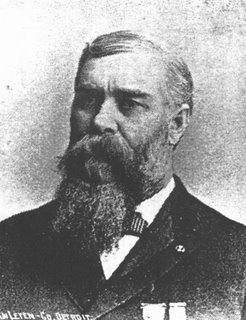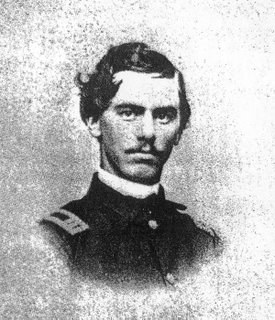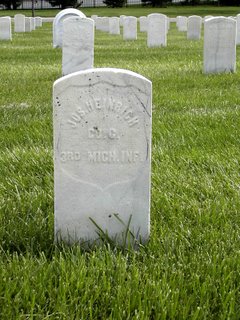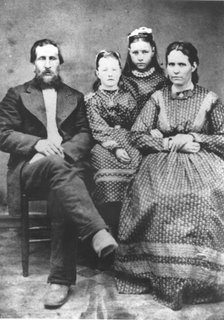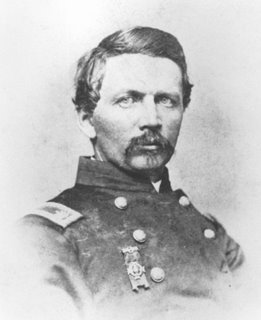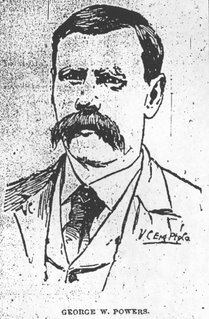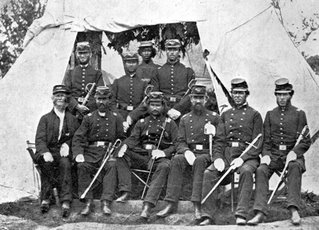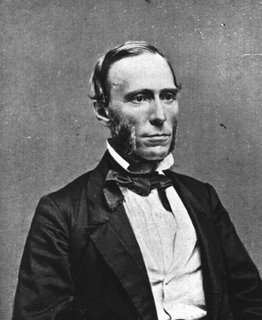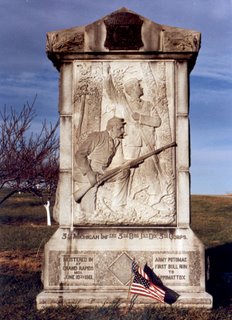
This isn't as easy to answer as you might think.
When the regiment began forming its companies in late April of 1861 the standard organizational requirements which required that a Regiment consist of ten companies of 100 officers and men consisting of a Captain, First Lieutenant, Second Lieutenant, Orderly or First Sergeant, 4 additional Sergeants, 8 Corporals, two Musicians (drummer and fifer), a wagoner, and the remainder privates; a small Field Staff consisting of Colonel, Lieutenant Colonel, Major, Adjutant, Quartermaster, Surgeon, Assistant Surgeon and Chaplain. (
photo: Col. Dan McConnell, postwar; source: Grand Rapids Public Library.)
Several enlisted men would also be detailed from the companies to serve as clerks for the Adjutant, Quartermaster and Chaplain, Hospital Steward and other assorted staff assistants as needed. Finally, there would be a Regimental Band made up of a Principal Musician or Drum Major and 18 musicians. The Regiment generally lived up to this standard.
The Field and Staff was comprised of Colonel Daniel McConnell, Lieutenant Colonel Ambrose Stevens, Major Stephen Champlin, Quartermaster Robert Collins, Adjutant Edward Earle, Surgeon Dr. D. Willard Bliss, his brother Zenas was Assistant Surgeon, the Rev. Francis Cuming was Chaplain, Walter Morrison was Hospital Steward, and Valentine Rebhun was Principal Musician and Drum Major. These men were joined by ten Captains, ten First Lieutenants, nine Second Lieutenants, 48 Sergeants, 78 Corporals, 19 Band members, ten wagoners and the rest Privates.
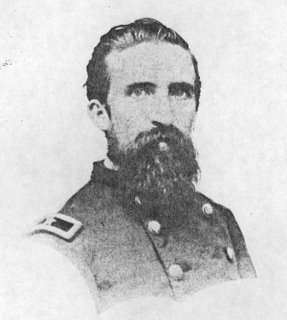
Although contemporary newspaper accounts placed the number of men who departed for Washington on June 13, 1861, at 1,050, present research of available sources leads to the conclusion that in fact 1,046 men were officially enrolled in the Third Michigan when the Regiment was mustered into federal service on June 10, 1861. Furthermore, of the 1,046 men who had been officially mustered into federal service perhaps as many as three dozen men remained in western Michigan on June 13, most of them sick. While most of these soldiers would eventually rejoin the Regiment, at least three of them would die in Michigan, and another two would join other units. William F. Fox in his exhaustive and thorough Regimental Losses in the Civil War claimed 1,040 men were mustered into federal service by June 13. This is the same number found in the Annual Report of the Adjutant General for the State of Michigan, 1862, although the previous year’s Annual Report numbered 1,042 men enlisted in the Third Michigan . John Robertson, who served as Adjutant General for the state of Michigan during the war, noted in his Michigan in the War, that 1,040 men were on the rolls when the Regiment left Grand Rapids on June 13, 1861, for Washington, DC. (
photo: Lt. Col. Ambrose Stevens; source: Grand Rapids Public Library.)
Fox, perhaps following the lead of the Annual Reports, claimed that the Third had a total enrollment of 1,238 during its organizational history from June 10, 1861 to June 10, 1864. However, the Annual Reports for 1862 through 1864 conclude that a total of 1,255 men enlisted in the Third Michigan. Specifically, the Annual Report, 1862, noted that as of July, 1862, an additional 123 names were added to the Regiment’s roster, which now totaled 1,163 men who had joined the regiment since the war began. The Annual Report, 1863 increased this number by 92 additional names, for a total by the end of the year of 1,255, quite close to Fox’s figure of 1,238.

In any case, present research shows these numbers of total enrolled in the Third infantry to be too low. When the Third Michigan left Michigan June 13, 1861, it had enrolled (inclusive of officers, musicians and wagoners) 102 men in A company, 100 in B company, 103 in C company, 101 in D company, 102 in E company, 103 in F company, 101 in G company, 102 in H company, 106 in I company and 99 in K company, with 8 men in the Field and Staff and 19 in the Band.
During the war, of 1,411 total enrolled, 127 men served in A company, 121 in B company, 132 in C, 134 in D, 164 in E, 130 in F, 125 in G, 128 in H, 144 in I, 130 in K, 45 in Unassigned, 19 in the Band and 11 served in the Field and Staff. According to the “Regimental Descriptive Rolls”, cross-checked through the military service records available at the National Archives, we find that during the lifetime of the Regiment 367 additional men joined the original group of 1,046 who had enlisted by June 10, 1861, thus giving a total of 1,411 men who served in the regiment during its existence. It should also be noted, however, that of the 1,411 at least 37 men remained unaccounted for, and it is fairly certain that at least 7 of those never joined the regiment and in fact went into other regiments. It is our conclusion (tentative to be sure) that the remaining 30 men (the vast majority of whom were originally and solely reported as having enlisted in “Unassigned”) likewise either joined other units or deserted or in some other fasion simply “disappeared. (
photo: Major Stephen Champlin; source: John Braden.)
We can say with some certainty that a total of 1,411 enlisted in the Third Michigan Infantry (first organization), of which 1,374 men served at one time or another and in one capacity or another in the Regiment.
Next: How old and how tall were they?
 One of the main objective of the numerous and various veterans organizations which spriung up throughout the country after the civil war was to seek monetary compensation for both the survivors of the war, as well as dependents of those who had perished during the conflict.
One of the main objective of the numerous and various veterans organizations which spriung up throughout the country after the civil war was to seek monetary compensation for both the survivors of the war, as well as dependents of those who had perished during the conflict.


